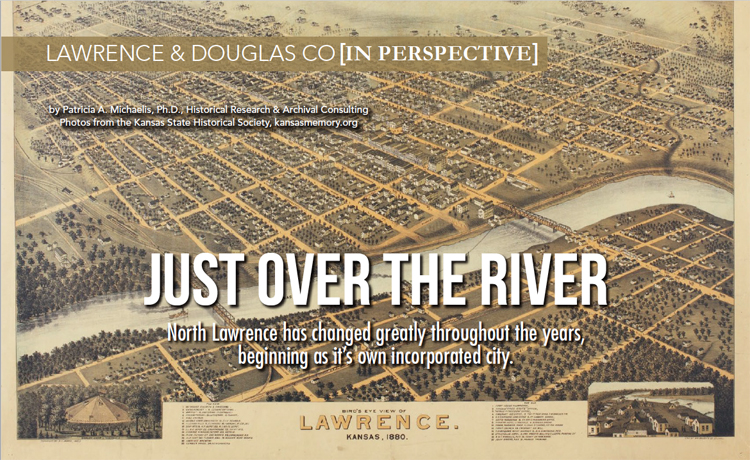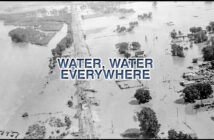North Lawrence has changed greatly throughout the years, beginning as it’s own incorporated city.
| 2018 Q4 | story by Patricia A. Michalis, Ph.D. | photos from the Kansas State Historical Society, Kansasmemory.org

caption
North Lawrence isn’t just that area across the Kansas River from the city of Lawrence. In the 1860s, it was an incorporated city. In 1854, the land on the north side of the river was part of Delaware Diminished Reserve lands, which had been established by treaty in 1829. Like most of the land in eastern Kansas, the United States government “gave” land in the west to Native American tribe members who had lived in parts of what became Illinois, Indiana, Michigan, Ohio and other states. Sometimes the grant of land was accompanied by cash payments, but these tribes were systematically “relocated” to land west of white settlements. With the passage of the Kansas-Nebraska Act in 1854, forming the territories of Kansas and Nebraska, and opening them up to settlement, the Native American tribes were forced to relocate once more to Indian Territory.
As the Delaware land rights were being renegotiated, easterners began settling the land, and a town was established on former American Indian lands. Originally called Jefferson, because that land was in Jefferson County, it was renamed North Lawrence as county boundaries were redrawn, and the area became part of Douglas County. The first settlers included G. J. Tallman, John Morehead, a Mr. Tibbets, M. Berry, Thomas McCage, W. H. H. Whitney, T. S. Murray and T. Laptab. Jefferson, and then North Lawrence, had a post office beginning in 1865. The first postmaster of Jefferson was Charles F. Saum; G. J. Tallman was the first postmaster for North Lawrence.
Living conditions, whether in North Lawrence or Lawrence, were less than ideal. The following description is from the spring 1954 issue of the Kansas Historical Quarterly:
- “Several log cabins are springing into existence. People are busily employed on hewing timber for frame houses. … The term frame house was used loosely in this instance and not in the professional architectural sense. Possibly, if not probably, some of the first of these frames had been hand-hewn with the intention of covering the frame with rough sawed lumber, but the failure of the sawmill to materialize and the compulsion of cold weather forced the substitution of other material … the framing timbers were hand-hewn poles, to which horizontal cross pieces were nailed, and to them in turn, split oak shakes about four feet in length were nailed. The first cabins of shakes, but on the hen-coop plan similar to the thatched houses built by the company, only smaller, were erected supposedly about the time of the Lum house, or just a little earlier. Instead of being covered with thatch, the sloping walls were covered with shakes. Doors were made of pole frames covered with cotton cloth. In some cases the roofs were made of cotton cloth, sometimes coated with tar.”
Since the road from Leavenworth that brought supplies to the area was on the north side of the Kansas River, there was a need for a way to cross the river. The first was a ferry owned by John Baldwin and C. W. Babcock. Baldwin erected a log building in North Lawrence and operated a rope-drawn flatboat ferry across the Kansas River beginning in 1855. The starting point for the ferry was located near the foot of North Third Street. C. W. Babcock, in his mid-thirties and single, partnered with Baldwin for two years. A more efficient means of crossing the river was needed, and the Lawrence Bridge Company was charted by the territorial legislature in 1859. The bridge was not completed until 1863, but it was an impressive structure for its time. Descriptions of the details of the bridge vary, but it was built on the Howe Truss pattern. There were four or five wooden spans about 30 feet above the low-water mark of the river. The spans rested on solid stone piers. In one account, it was 690 feet long and cost $47,000. The ferry was closed after the completion of the bridge.
The most important means of transportation for North Lawrence was a railroad. It began in 1855 as the Leavenworth, Pawnee and Western Railroad, but was reorganized in 1863 as the Union Pacific, Eastern Division. The company began construction on its main line westward from Kansas City in September 1863. In December 1864, the first 40 miles of the line to Lawrence was in operation, but the tracks and depot were actually located in North Lawrence. The depot was used for both passengers and freight, and was a one-story building, 100 x 26 feet, located near the intersection of Locust and North Fifth streets. It also housed the offices of railroad officials. Some of the earliest photos of North Lawrence were part of Alexander Gardner’s series, “Across the Continent on the Union Pacific Railway, Eastern Division.”
A number of businesses were established in North Lawrence in the 1850s and 1860s, and the main business district was located along Bridge (opposite Massachusetts Street, in Downtown Lawrence) and Locust streets. One of the earliest businesses was a sawmill and lumber business operated by Charles Bruce, who emigrated to Kansas territory from Niles, Michigan, in 1856. These businesses were located on the northeast corner of North Third and Locust streets, but were later relocated. John Moorehead operated a trader’s store in North Lawrence in these early years, as well. Other North Lawrence residents included Dr. G. J. Tallman; Charles F. Saum, a carpenter; Thomas McCage, a merchant; O. H. Mitchell, a carpenter; M H. Berry, who operated a bowling alley; and Isaac Tibbets, a grocer. By the 1860s, North Lawrence had a general store, which sold anything from groceries to harnesses. There were a number of grocery stores, a barbershop, a meat market, a bakery, a saloon and a drug store. The first newspaper in the community was the North Lawrence Courier, whose first edition was distributed on July 28, 1866. It’s name was changed several times: Kaw Valley Courier ,the Clarion and the North Lawrence Journal.
Woodland and Lincoln schools were established in North Lawrence but were originally named First Ward and Second Ward schools.The Pilgrim Congregational Church was established in 1865, with the church building and parsonage located at the northwest corner of Elm and North Third streets. The Centenary Methodist Episcopal Church was organized in 1865, but its church was not built until 1866.
North Lawrence was incorporated as a city of the second class by the Kansas Legislature in 1867. The results of its first election as a city included G. H. Tallman, mayor; N. Hoystradt, clerk; A. R. Smith, treasurer; Thomas Beasley, marshal; and H. H. Howard, police judge.
The existence of North Lawrence as an independent city was short-lived. As early as 1867, residents were petitioning the Lawrence city government for annexation. In March 1870, in separate elections, the citizens of North Lawrence and Lawrence approved the annexation. April 4, 1870, was set as the day to elect new city officials for the newly consolidated community. These events established the area of North Lawrence as a formal part of the city of Lawrence, which is just “over the river.”



